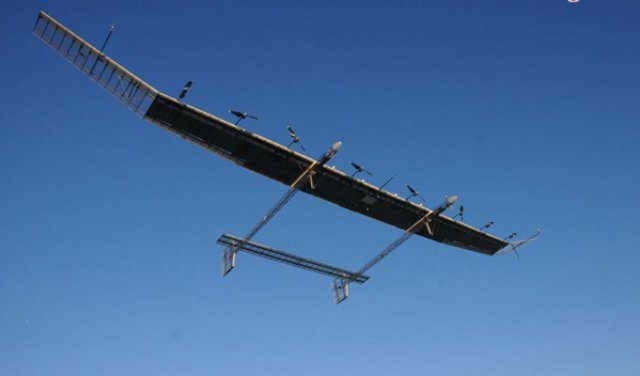China’s aerospace engineers boast the “Caihong” is the world’s largest solar-powered drone, dwarfing NASA’s Pathfinder series that never made it into mass production. The prospect of the drone leading in disaster monitoring is in the horizon.
A large-scale solar-powered unmanned aerial vehicle (UAV), latest in the “Caihong” (rainbow in English) series produced by the China Academy of Aerospace Aerodynamics (CAAA), will make its maiden flight by midyear, China.org.cn has learnt.
The UAV will seek to reach near-space, an altitude above where commercial airliners fly, but below orbiting satellites.
Such a vehicle is commonly referred to as an “atmospheric satellite” in that it can function as a low-orbit satellite to a certain extent. A solar UAV can perform sustained surveillance and information-relay over a region.
It usually features longer hovering time, higher communication capacity and higher image resolution than a usual reconnaissance satellite that can only visit a designated region periodically. Besides, the price of a solar UAV and its launch cost are far lower than a satellite.
The Chinese vehicle has a wingspan of more than 40 meters. It has eight propellers installed on the front of the wings fully covered by solar panels. Its designer, CAAA’s chief UAV engineer Shi Wen, calls it the world’s largest solar-powered drone, even dwarfing the US NASA Pathfinder series that never made it into mass production.
Shi said his UAV is among the world’s top three in terms of its overall performance indicators and technical capabilities.
Super-high service ceiling, super-long endurance and easy maintenance are the three key aspects to ensure solar drones to perform a leading role in such fields as extensive aerial reconnaissance, disaster monitoring and communication relay.
The Chinese vehicle can easily stay airborne for months. “If we don’t consider the life span of the parts, this kind of aerial vehicle could theoretically fly forever,” said its designer.
The challenges in designing a solar drone mainly involve its aerodynamic layout and wing configuration, because there was no established template to follow. Shi said that a higher lift-to-drag ratio, to optimise the drone’s aerodynamic layout, was essential, and this was something the CAAA had built its reputation upon.
CAAA is a subsidiary of the NASA-like China Aerospace Science and Technology Corporation. Its principal mission is to test the aerodynamic performance of China’s aerial and aerospace vehicles, including rockets, space modules and atmospheric reentry-vehicles of long-range projectiles.
CAAA started to develop the Rainbow drones to break the monopoly of the US drones such as Global Hawk and Reaper in the global arms market. CH-3 and CH-4 are the star products of the Rainbow series. They have already displayed their capabilities in geological and maritime surveillance at home as well as anti-terrorism activities in the Middle East and Africa.
At the International Defense Exhibition (IDEX) 2017 held in Abu Dhabi last month, Saudi Arabia announced it would manufacture certain types of Rainbow UAVs, after inking deals with CAAA. Military insiders claim the CH-4 has a strong possibility for mass manufacture, but no comment was available from CAAA.
Source: Eco-Business

